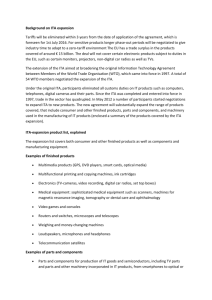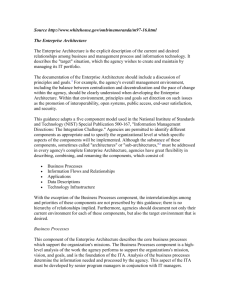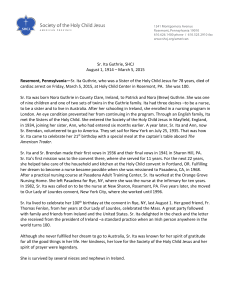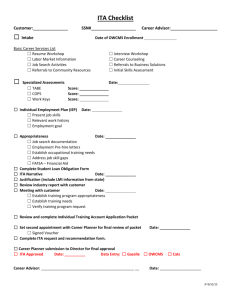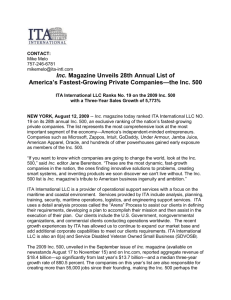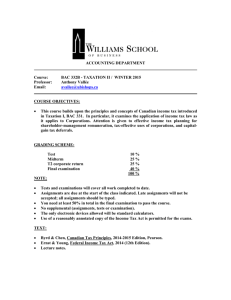A Telephone Adapter for Internet Telephony Systems
advertisement
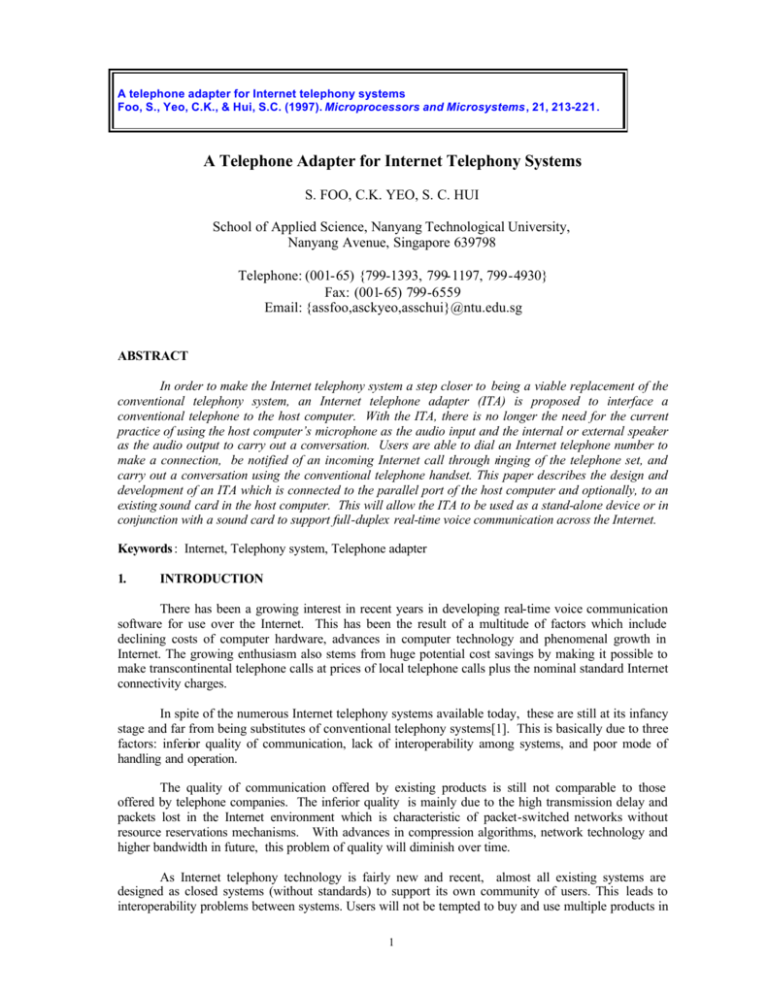
A telephone adapter for Internet telephony systems
Foo, S., Yeo, C.K., & Hui, S.C. (1997). Microprocessors and Microsystems, 21, 213-221.
A Telephone Adapter for Internet Telephony Systems
S. FOO, C.K. YEO, S. C. HUI
School of Applied Science, Nanyang Technological University,
Nanyang Avenue, Singapore 639798
Telephone: (001-65) {799-1393, 799-1197, 799-4930}
Fax: (001-65) 799-6559
Email: {assfoo,asckyeo,asschui}@ntu.edu.sg
ABSTRACT
In order to make the Internet telephony system a step closer to being a viable replacement of the
conventional telephony system, an Internet telephone adapter (ITA) is proposed to interface a
conventional telephone to the host computer. With the ITA, there is no longer the need for the current
practice of using the host computer’s microphone as the audio input and the internal or external speaker
as the audio output to carry out a conversation. Users are able to dial an Internet telephone number to
make a connection, be notified of an incoming Internet call through ringing of the telephone set, and
carry out a conversation using the conventional telephone handset. This paper describes the design and
development of an ITA which is connected to the parallel port of the host computer and optionally, to an
existing sound card in the host computer. This will allow the ITA to be used as a stand-alone device or in
conjunction with a sound card to support full-duplex real-time voice communication across the Internet.
Keywords : Internet, Telephony system, Telephone adapter
1.
INTRODUCTION
There has been a growing interest in recent years in developing real-time voice communication
software for use over the Internet. This has been the result of a multitude of factors which include
declining costs of computer hardware, advances in computer technology and phenomenal growth in
Internet. The growing enthusiasm also stems from huge potential cost savings by making it possible to
make transcontinental telephone calls at prices of local telephone calls plus the nominal standard Internet
connectivity charges.
In spite of the numerous Internet telephony systems available today, these are still at its infancy
stage and far from being substitutes of conventional telephony systems[1]. This is basically due to three
factors: inferior quality of communication, lack of interoperability among systems, and poor mode of
handling and operation.
The quality of communication offered by existing products is still not comparable to those
offered by telephone companies. The inferior quality is mainly due to the high transmission delay and
packets lost in the Internet environment which is characteristic of packet-switched networks without
resource reservations mechanisms. With advances in compression algorithms, network technology and
higher bandwidth in future, this problem of quality will diminish over time.
As Internet telephony technology is fairly new and recent, almost all existing systems are
designed as closed systems (without standards) to support its own community of users. This leads to
interoperability problems between systems. Users will not be tempted to buy and use multiple products in
1
order to communicate with other users. The problem will remain until some form of a standard (such as
H.323[2]) emerges or if the whole market is dominated by some particular product.
In terms of handling and operation, existing Internet telephony systems generally require a caller
to define the identity of a recipient through some form of cryptic computer input in order to make a
connection. This input takes the form of an IP address, recipient’s name, electronic mail address,
Universal Resource Locator (URL) or a special Internet telephone number. Apart from the last form
(which the authors have yet to detect in any existing system), this mode of operation is totally different
from using a conventional telephone. In addition, these systems rely on the host computer’s microphone
as the audio input device and the internal speaker as the output device to carry out a conversation. This is
both awkward and unnatural. In addition, it does not provide privacy as the speaker’s output is audible to
people around unless a low enough volume or a headset is used. Thus, there is a need to ensure that the
Internet telephone system can emulate a conventional telephone as closely as possible both in terms of
handling and operation. In this respect, this paper proposes that the Internet telephony environment
should include an Internet telephone adapter (ITA) to interface a conventional telephone to the host
computer.
2.
SYSTEM REQUIREMENTS
Host computer
Host computer
Internet
Telephone
Adapter
Local Area Network
Internet
Telephone
Adapter
Modem
Modem
Internet
Service
Provider
Router
Local Area Network
Internet
Router
Figure 1. Internet Telephone Environment with ITA
Figure 1 shows the Internet telephone environment that uses an ITA to connect a conventional
telephone set to the host computer. With the ITA, it becomes possible to support both the Public
Switched Telephone Network (PSTN) and the Internet telephony systems. With this configuration, voice
communication between users is carried out using a conventional telephone set whose hands et houses the
mouthpiece and loudspeaker. This effectively replaces the host computer’s microphone and internal
speaker for audio input and output operations. The software system interfaces with the telephone to
accept direct tone connections. Thus, instead of using computer input to define the recipient, the caller
can dial up an Internet telephone number, IP address or some other pre-defined number sequence. A
look-up table on the host computer is used to translate the numeric input into the required form for
connection.
A request for connection can activate the ringing mechanism of the telephone set so that users are
informed of incoming calls in the conventional way. A pre-recorded message at the host computer could
be played back to the recipient to indicate that it is an Internet call as opposed to a normal trunk call.
2
Alternatively, the telephone could be set to have a different ringing tone to differentiate calls between the
two systems.
The ITA can be extended to incorporate a number of other features. It can be used as a telephone
recorder to capture on-going conversation over the Internet telephone system. Conversely, it becomes
possible to playback pre-recorded audio during an on-going conversation so that it is audible to both
parties. Finally, it is also possible to utilize the DTMF decoder functionality to create applications
with automatic answering facilities.
In order to support these desired features, the ITA is designed to satisfy the following system
requirements:
•
•
•
•
•
•
•
•
3.
The ITA supports both Internet and PSTN telephony systems. The ITA connects a conventional
telephone or speaker phone set to the host computer to support both forms of telephony system.
The ITA is an external device that connects to the host computer via the parallel port for data
exchange and control. This eliminates the need for limited and valuable slots on the host computer.
The ITA functions with host computers that may or may not have a sound card or in-built audio
capabilities. In this instance, some form of audio data sampling and conversion module must exist
on the ITA.
The ITA has the ability to capture touch-tone inputs from the telephone keypad. This enables an
Internet telephone number or other numeric sequence to be captured by the Internet telephone
software.
The ITA is capable of ringing the telephone set and utilizing a different ring tone to differentiate
conventional calls from Internet calls.
At the default or power -down state, the ITA ensures the telephone set and the parallel port ar e used
for normal operations.
The ITA is an externally powered device with a power input rating of 110/230VAC 50-60Hz.
A set of Application Programming Interfaces (APIs) is provided to allow the complete control of the
ITA for extended functions such as record and playback, and to develop any other customized
applications.
HARDWARE SYSTEM DESIGN
As shown in Figure 2, the ITA comprises a number of modules to support the necessary system
requirements of the previous section:
•
Subscriber Line Interface Circuit (SLIC) links the ITA to the telephone set and converts the differential
signals from the telephone microphone to a single -ended analogue signal and vice versa. It provides the
48V dc to operate the telephone when the ITA is in operation and also detects off-hook signals
generated by the telephone when the handset is picked up or replaced. Discrete components, mainly
transistors, are used in the design of the SLIC to minimise cost as opposed to the use of commercial
SLIC chips such as the Mitel MH886 12.
•
The CODEC is essentially a combined analogue-to-digital converter (ADC) and a digital-to-analogue
converter (DAC) using the µ-law companding. It digitises the audio signal for onward transmission via
Internet when a call is made and converts the received digital audio into analogue signals when a call is
received. The Motorola MC145500 CODEC with both the µ-law and A-law companding capabilities is
used for design flexibility.
3
Central Office
(Trunk Line)
DPCO
Relay 1
Audio IN
Subscriber
Line Interface
Circuit
Ringer
Audio OUT
DTMF
Decoder
Analogue
Adder and
Analogue
Switch
Register
Analogue
Split and
Analogue
Switch
Tone
Generator
PCM, µ-law companding
CODEC
Register
Register
Signal
Conditioning
Op-Amp
Signal
Conditioning
Op-Amp
Control
Unit
Multiplexer
Parallel Interface Module
DPCO
Relay 2
ITA Printer Parallel Port
Host Computer Parallel Port
Audio Card I/O
Data Lines
Control Lines
Figure 2. Hardware Block Diagram of ITA
In the presence of a sound card on the host computer, the CODEC is bypassed as its functions can be
performed by the sound card itself. A signal conditioning module, comprising essentially operational
amplifiers circuitry will condition the signal to the optimum level for interfacing to any sound input-output
devices.
As this device has only serial interface, two shift registers are needed, one for input and the other for output.
•
Analogue switches are needed to control which analogue signals are to be connected to the CODEC. As
recording and playback features are desired, analogue adding and splitting of signals are needed to
record and play back the conversation for the parties to listen to. These modules are built using
operational amplifiers circuitry.
•
DTMF Decoder Unit is used to decode the DTMF tones generated by the touch-tone keypad from the
telephone. A simple Motorola MC145436 DTMF receiver is enough to provide 4-bit hexadecimal code
for the standard 16 digits tones generated by the telephone. The decoded digits are then transmitted to
the host computer for purposes such as IP addresses and control codes recognition.
4
•
DPCO (Double Pole Changeover) Relay 1 directly connects the trunk line to the telephone set in the
event of a power failure or when the user chooses to bypass the ITA. When the ITA is in operation, no
calls will be forwarded through the trunk line as the calls are conducted via the Internet. As such, the
DPCO relays will simply disconnect the trunk line from the SLIC of the telephone set. The
incorporation of the relay thus allows dual operation of the telephone set by the user for both normal and
Internet telephony.
•
DPCO Relay 2 is used to connect the parallel port of the computer to the printer port for normal printing.
This is to ensure that in the event of a power failure, the parallel port can be used solely for printing
purposes.
•
The tone generator produces the basic dial tone from which the ring tone is generated for use by the
ringer circuit. The dial tone is a 400 Hz pure sine wave. A Wien Bridge Oscillator is used to generate the
dial tone. The busy tone is derived from the dial tone by modulating the sine wave at an on-off interval
of 0.4s each, the waveform of which is provided by a 555 timer. The busy tone is used by the ringer
circuit to ring the telephone instead of the conventional ring tone. This is to enable user to differentiate
incoming Internet calls from ordinary incoming calls.
•
The ring current is derived from the busy tone generated above. The busy tone is boosted by a Class AB
Push-Pull amplifier to obtain a sufficiently strong current to ring the telephone set. A 1:10 step-up
transformer is subsequently used to step up the voltage to achieve 75 Vrms.
•
Multiplexer is used to share the bus interface of the parallel port. As the host computer can either read or
send data, the multiplexer serves to send and receive the correct set of data to the respective registers. Bus
transceivers with logic gates for controlling the direction of data flow are used.
•
Signal Conditioning Module comprises two operational amplifiers to condition the signal to the optimum
level for interfacing to the audio input-output device on the host computer. One amplifier is used to
condition the input audio signal from the microphone and the other is to condition the output signal to the
speaker.
•
Control Unit is the ‘brain’ of the ITA. It comprises the following modules:
- Clock Generator Module generates the necessary clock signals for the different parts of the system.
This is the main synchronising module for the ITA. This module can be constructed using an
oscillator and counters to divide the clock into the various required frequencies.
- Memory Module stores the state of the device (i.e. active/inactive) as well as protocol information to
interface with the software. It may be utilised to store any data or control information needed for any
future expansion purposes. Flip flops circuitry is used for this purposes.
- Digital Speech Input Synchronisation Module controls the reading of the digit ised speech signal from
the parallel port and channels it to the CODEC for conversion to the analogue equivalent for the
telephone speaker. Logic gates are used to produce proper control signals for the different units to
operate correctly.
- Analogue Speech Output Synchronisation Module reads the analogue speech signals from the
telephone microphone, directs it to the CODEC for digitisation, and sends the digital speech signals to
the parallel port of the host computer. Control signals, derived from logic gates are used to operate the
different units.
- Activation Code Detector Circuit detects codes from the parallel port and determines when to activate
the ITA or when to shut it down. In a shut-down condition, it will enable the telephone to be
connected to the trunk line and the computer parallel port to function as a normal printer port. These
are accomplished via the use of DPCO Relays 1 and 2.
5
- Control Codes Decoding Module decodes and executes instructions from the parallel port. Examples
of such instructions include relay on/off, ITA activation/shut down and bypassing the CODEC at the
presence of the sound card. This can be easily implemented using decoders/demultiplexers to decode
the various commands.
4.
SOFTWARE SYSTEM DESIGN
Telephone Software
Telephone Exchange
Internet Telephone Adapter APIs
Audio
Management
Playback
(Audio)
Quality
Monitor
Control
Packets Lost
Replacement
Control
Record
(Audio)
Packet
Time-stamping
Buffer
Management
& Packet
Ordering
Compression
Decompression
Tx
Session
Management
Network
Communication
(UDP/IP)
Rx
Registration
Negotiation
Control
Network
Communication
(TCP)
Data Store
of Active
Users
Network
Communication
(TCP)
To remote network
Figure 3. Internet Telephone Environment with ITA
As shown in Figure 3, the ITA is interfaced to the Internet telephone software system via the parallel
port and driven by a set of Application Programming Interfaces (APIs). The set of APIs is derived from a set
of basic primitives operations that is supported by the ITA. This is shown in Table 1. There are two main
components in the Internet telephone software system, namely, Telephone Exchange and Telephone
Software. As the name implies, the Telephone Exchange acts as an exchange to aid connectivity between
active Internet telephone users. The Telephone Software component comprises a user interface for session
control and audio management processes. This segregation is necessary to cater for the different roles
played by each process to support the real-time nature of the communication process.
Session management is concerned with negotiating and monitoring of session parameters. Three
processes are utilised in session management: control, negotiation and network communication
process. The control process receives a caller’s request for connection with a recipient and attempts to
establish a communication path between the two parties. The recipient's 'Internet telephone number' is
input directly from the conventional telephone. The Telephone Exchange is contacted to retrieve the
IP address of the recipient. With this information, a call set-up with the recipient is subsequently
6
initiated. The negotiation process takes over to handle the arbitration of communication parameters
between both parties before actual communication can take place. With all communication parameters
resolved, the negotiation process will signal the audio management process to initiate the conversation.
Finally, the network communication process provides the transportation functionality to dispatch
messages to and from the recipient using TCP.
Table 1. Command Primitives Supported by ITA
Primitive
Description
detect_device
detect availability of ITA
send_data
send one byte of data to the ITA
read_data
read one byte of data from the ITA
send_command
send selected instruction to ITA
read_status
read status_register of ITA
read_DTMF_data
read DTMF decoded data
Audio management is responsible for audio transmission from the recording and playback
operations to the transmitting and receiving operations. Audio transmission is periodic with audio
sampled at regular time intervals and goes through a series of processes prior to being transmitted.
Although, the occasional non-delivery of audio packets will reduce the quality of communication, it
will not be disastrous, provided that small audio samples are dispatched each time and that some inbuilt mechanisms exist to cater for lost data replacement. A number of processes are required to fulfil
the role played by audio management:
The Record/Playback (Audio) process provides the necessary audio interface for recording,
playing back and adjustment of audio characteristics. It interfaces with the ITA and hence the
conventional telephone to capture and playback the audio data. Each packet of audio sample obtained
from the telephone is linearly time-stamped by the packet time-stamping process to indicate the instant
of sampling. This allows the packets arriving at the recipient’s host computer to be ordered in the
correct time sequence before being played back. The audio data is optionally compressed by the
compression process and sent to the recipient's host computer through the network communication
process using UDP/IP.
At the recipient's host computer, audio data arriving are correspondingly decompressed by the
decompression process before being buffered and ordered by the buffer management and packet
ordering process. The purpose of buffer management is to cushion the out-of-order, late delivery and
jitters experienced by the packets. Audio packets are ordered in sequential order using a ring buffer to
store audio samples. A margin of safety is usually set in the total buffer space to take into account of
jitters. If a safety factor of 2 is used, then the play-out point occurs when the ring buffer is half full.
Prior to playback, the packet lost replacement control process is activated to identify and handle
packets lost as a result of unreliable network transmission.
5.
SYSTEM OPERATION
The ITA is physically connected to the trunk line, telephone set and the printer port of the PC. When
the power of the ITA is not switched on, it is totally bypassed. In other words, the telephone set will function
as a PSTN telephone while the printer port will be servicing the printer.
Figure 4 shows the communication process which takes place when the ITA is in operation. To start
the Internet telephony application, the user must first run the Telephone Software on the PC. Upon the ITA
being powered up, the ITA API residing on the PC will detect its status and signal the Telephone Software to
register the ITA’s presence. All calls made on the telephone set will thereafter be channelled via the ITA
through the Internet instead of the PSTN.
To make a call, the user simply lifts the handset. The ITA will then connect the dial tone to
completely emulate the PSTN environment. The user enters the destination phone number which is then fed
7
to the Telephone Software. As can be seen in Figure 4, the Telephony Software will query the remote
Telephony Exchange for the corresponding IP address and subsequently request for a connection. The call is
set up if the connection is successful otherwise a busy tone will be conveyed to the user handset by the ITA to
signify that the destination line is busy. On the receiver side, upon receipt of the request for connection, the
Telephone Software will instruct the ITA’s API to check if the recipient’s telephone is onhook. If so, the ITA
will ring the telephone. If the line is offhook, the ITA will report to the Telephone Software that the
connection cannot be put through. When the call is answered, the ITA will inform the Telephone Software to
signal successful connection.
Upon successful connection, audio conversation commences. The ITA basically digitalises the analogue
speech data and transmit the resulting digital signals to the Telephone Software. Either party can terminate
the call by setting the telephone onhook. ITA detects the status and conveys it to the Telephone Software
which in turn relays the hang-up status to the caller side. The ITA on the caller side will thus send a dial tone
to signify that the call is terminated. The users will respectively replace their handsets. To term inate the
Internet telephony application, the user just needs to switch off the ITA and terminate the Telephone
Software running on the PC.
6.
SYSTEM REVIEW AND EVALUATION
The proposed ITA is successfully designed, constructed and interfaced with our prototype Internet
Telephone Software System [3-4]. The basic features have been tested and verified. The feasibility of
using the ITA to support both conventional and Internet telephony systems has been demonstrated. In
both systems, the conventional telephone or speaker-phone is used to carry out a conversation. The ITA
connects to the parallel port of the host computer and can be optionally used with an existing sound card.
At the default and power-down state, it allows the printer parallel port to be used for printing and
conventional telephone operations to be carried out. When in use for Internet telephone operations, the
printer port is set to busy status so that the printer (or any device connected to the parallel port) cannot be
used concurrently. In this case, new print jobs cannot be sent directly to the printer but is put into the
print queue ready to resume once the conversation terminates.
As Internet telephony systems are fairly new, it should not be surprising that there are only a few
Internet telephone adapters on the market. However, there is no doubt that this number will increase
significantly as Internet telephone becomes commonplace. Three existing ITA products are compared in
this section for completeness:
The Internet Telephone Adapter [5] is a low -cost simple interface between a host computer’s
sound card and a telephone. It interfaces with a host’s computer sound card via the standard speaker and
mike jacks. The inability to fully emulate the functions of normal telephony for more natural Internet
telephony operations and its exclusive use of the telephone set for Internet telephony only are its main
disadvantages.
The Advanced Internet Telephone Interface [6] is mainly designed for use in an office
environment to handle selling through voice mail and recording personalized messages. It connects the
host computer’s sound card to a conventional telephone via two separate inputs, one for the telephone’s
handset/ headset and the other for the telephone set itself. With this setup, the handset/headset can be
used for all sound card applications and a connection is achieved between the sound card and the
telephone line. The two somewhat functional similarities with the ITA lie in allowing the handset/headset
to be used for Internet conversations and the ability to perform static record and playback. However, the
Advanced Internet Telephone Interface also exhibits the same disadvantages as the Internet Telephone
Adapter when compared with the proposed ITA.
Finally, SoundXchange [7] is essentially a customised speaker phone system to render Internet
telephony easier to use. It comes in various models and is hung alongside the host computer’s monitor to
connect to any previously installed sound card or to any computer with built-in audio capabilities through
the standard mini jacks. The model which somewhat resembles the proposed ITA has a built-in sound
board and plugs into the parallel port of a computer, and a pass-through connector to allow for a parallel
port printer. This has the advantage of eliminating the need to install a sound card in the host computer
8
and taking up one of its limited slots. It is used for Windows 3.1 applications that do not require any
duplexing. However, it lacks the support for full duplex operations and is hence not optimally designed
for Internet telephony usage. The telephone set is confined to being a stand-alone device for computer based audio applications and is not connected to the PSTN for conventional telephone usage.
From these brief reviews, it is apparent that the proposed ITA has been designed to exhibit a host
of additional features and functionality over and above what is currently available.
7.
CONCLUSION
This paper has examined the Internet telephony environment and propos ed the inclusion of an
ITA to connect a conventional telephone set to the host computer. In doing so, it becomes possible to
improve the handling and usage of Internet telephony system thereby removing one of the factors
inhibiting it from widespread adoption and use. This paper has demonstrated, through the design and
implementation of an ITA, the feasibility of using this approach to connect a conventional telephone set
to the host computer to support both Internet and PSTN telephony systems.
REFERENCES
[1]
[2]
[3]
[4]
[5]
[6]
[7]
G. Venditto, Internet Phones: The future is calling, Internet World, June 1996, pp. 40-52.
International Telecommunication Union (ITU). Recommendation H.323. <URL:
http://www.itu.ch/>
S. Foo, K.V. Chin, S.C. Hui, An Approach to Real-Time Voice Communication over the Internet,
Proc. of 1996 Int. Symposium on New Transmission & Switching Technologies, Kunming,
China, September 1996, pp. 489 - 492.
K.V. Chin, S.C. Hui, S. Foo, Communication Protocol for an Internet Telephone Software
System, Proc. of 1996 Int. Conference on Communication Systems, Singapore, November 1996,
pp. 10.10.1-10.10.5
Jech Tech Inc. Product Catalogue: Internet Telephone Adapter <URL:
http://www.infinet.com/~jectech/ita.html>
A&D Design. VMB/60 : An adva nced Internet telephone interface. <URL:
http://www2.best.com/~vmb60/ftel-app.htm>
InterActive Inc. Product Catalogue: SoundXchange <URL: http://www.iact.com/sxc.html>
9
BIOGRAPHIES
Schubert Foo received his B.Sc. (Hons) in Mechanical Engineering, Ph.D. in Materials
Engineering, and M.B.A. from the University of Strathclyde in 1982, 1985 and 1989
respectively. He joined Babcock’s Research Centre in Renfrew, UK as a Project
Engineer in 1985. He subsequently became Systems Consultant specializing in
developing real-time software for the process and power industries. He is currently
Head of the Division of Information Studies, Nanyang Technological University. His
current research interests include multimedia technology, Internet technology, CSCW
systems, digital libraries and project management.
Chai Kiat Yeo received her B.Eng. (Hons) and M.Sc. degrees in 1987 and 1991
respectively, both in electrical engineering, from the National University of Singapore. She
was a Principal Engineer with Singapore Technologies Electronics & Engineering Limited
prior to joining the Nanyang Technological University as Lecturer in 1993. Her current
research interests include speech and digital signal processing, microprocessor and digital
signal processor-based applications.
Siu Cheung Hui is Senior Lecturer in the Division of Software Systems at the Nanyang
Technological University, Singapore. He received his B.Sc. degree in Mathematics in
1983 and a D. Phil degree in Computer Science in 1987 from the University of Sussex,
UK. He worked in IBM China/Hong Kong Corporation as a system engineer from 1987 to
1990. His current research interests include document retrieval, database systems, Internet
technology and multimedia systems.
10
Internet
Registration
User A
ITA
TS
TE
TS
Run TS
Power On
ITA On
On-line
User B
ITA
Run TS
Registering
Registering
ITA On
Power On
Registered
Find B's address
Offhook
Call
Set-up
TE
Registered
Query remote TE
On-line
IP address returned
Dial Tone
Tel
B's address returned
Connect
Request connection
DTMF Tones
Num
Call
Answered
Confirmed connection
Connected
Ring Phone
Offhook
Call
DeRegistration Termination
Audio
Exchange
Negotiation of Audio Parameters
Analogue voice
Analogue voice
Digitised voice exchange
Onhook
Hangup
Request Disconnection
Hangup
Confirmed Disconnection
Onhook
Power Off
Exit
Off-line
De-Registering
De-Registered
Figure 4. Communication Process Between Two Internet Telephone Users
Microprocessors and Microsystems
S. Foo, C.K. Yeo, S. C. Hui
11
